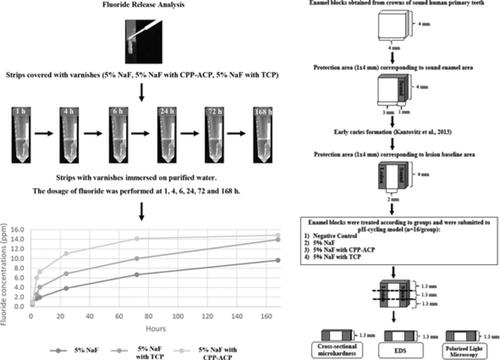当前位置:
X-MOL 学术
›
Microsc. Res. Tech.
›
论文详情
Our official English website, www.x-mol.net, welcomes your
feedback! (Note: you will need to create a separate account there.)
Fluoride release and remineralizing potential of varnishes in early caries lesions in primary teeth
Microscopy Research and Technique ( IF 2.0 ) Pub Date : 2020-12-05 , DOI: 10.1002/jemt.23662 Aline Laignier Soares-Yoshikawa 1 , Thais Varanda 1 , Alexsandra Shizue Iwamoto 1 , Kamila Rosamilia Kantovitz 1, 2 , Regina Maria Puppin-Rontani 1 , Fernanda Miori Pascon 1
Microscopy Research and Technique ( IF 2.0 ) Pub Date : 2020-12-05 , DOI: 10.1002/jemt.23662 Aline Laignier Soares-Yoshikawa 1 , Thais Varanda 1 , Alexsandra Shizue Iwamoto 1 , Kamila Rosamilia Kantovitz 1, 2 , Regina Maria Puppin-Rontani 1 , Fernanda Miori Pascon 1
Affiliation

|
This study evaluated the fluoride (F) release and remineralizing potential of varnishes containing sodium fluoride (5% NaF), 5% NaF with CPP‐ACP and 5% NaF with TCP in early caries lesions in primary teeth. To determine the F release at 1, 4, 6, 24, 72, and 168 hr, strips were covered with the varnishes and immersed in purified water (n = 7). The varnishes and purified water (negative control) were applied on enamel blocks with early caries lesions (n = 16). Enamel blocks were stored in artificial saliva and submitted to a pH‐cycling. The area of enamel hardness loss (ΔS) was analyzed by microhardness, lesion depth by polarized light microscopy (PLM) and the chemical analysis by Energy‐dispersive X‐ray spectroscopy. Data were submitted to Shapiro–Wilk, two‐way and one‐way ANOVA, Tukey and paired t‐tests (α = 5%). All varnishes released F, but 5% NaF with CPP‐ACP had the highest release at 4, 6, 24, and 72 hr (p < .05) followed by 5% NaF with TCP and 5% NaF. No significant difference in ΔS was observed among varnishes (5% NaF = 4,098.4 ± 1,407.9; 5% NaF with CPP‐ACP = 4,164.0 ± 1,019.3; 5% NaF with TCP = 4,183.2 ± 1,527.2; p = .999), but all of them differed from the negative control group (6,757.8 ± 2,274.7; p < .001). Lesion depth was lower in varnishes groups compared to negative control (% reduction: 5% NaF = 41.8%, 5% NaF with CPP‐ACP = 38.8%, and 5% NaF with TCP = 36.3%; p < .001). Similar Ca, P, and Ca/P ratio percentages among groups and F was not detected after the treatments. All fluoride varnishes showed potential to enhance remineralization of early caries lesions in primary teeth.
中文翻译:

乳牙早期龋损中清漆的氟化物释放和再矿化潜力
本研究评估了含有氟化钠 (5% NaF)、5% NaF 和 CPP-ACP 以及 5% NaF 和 TCP 的清漆在乳牙早期龋损中的氟化物 (F) 释放和再矿化潜力。为了确定在 1、4、6、24、72 和 168 小时时的 F 释放,将条带涂上清漆并浸入纯净水中 ( n = 7)。将清漆和纯净水(阴性对照)涂在有早期龋损的釉质块上(n= 16)。牙釉质块被储存在人工唾液中并进行 pH 值循环。通过显微硬度、偏光显微镜 (PLM) 和能量色散 X 射线光谱仪的化学分析来分析牙釉质硬度损失的面积 (ΔS)。数据提交给 Shapiro-Wilk、双向和单向方差分析、Tukey 和配对t检验 (α = 5%)。所有清漆都释放 F,但 5% NaF 和 CPP-ACP 在 4、6、24 和 72 小时时释放最高 ( p < .05),其次是 5% NaF 和 TCP 和 5% NaF。在清漆中未观察到 ΔS 的显着差异(5% NaF = 4,098.4 ± 1,407.9;5% NaF,CPP-ACP = 4,164.0 ± 1,019.3;5% NaF,TCP = 4,183.2 ± 1,527.2;p= .999),但它们都与阴性对照组不同(6,757.8 ± 2,274.7;p < .001)。与阴性对照相比,清漆组的病变深度较低(减少百分比:5% NaF = 41.8%,CPP-ACP 减少 5% NaF = 38.8%,TCP 减少 5% NaF = 36.3%;p < .001)。治疗后未检测到组间和 F 之间相似的 Ca、P 和 Ca/P 比率百分比。所有氟化物清漆都显示出增强乳牙早期龋损再矿化的潜力。
更新日期:2020-12-05
中文翻译:

乳牙早期龋损中清漆的氟化物释放和再矿化潜力
本研究评估了含有氟化钠 (5% NaF)、5% NaF 和 CPP-ACP 以及 5% NaF 和 TCP 的清漆在乳牙早期龋损中的氟化物 (F) 释放和再矿化潜力。为了确定在 1、4、6、24、72 和 168 小时时的 F 释放,将条带涂上清漆并浸入纯净水中 ( n = 7)。将清漆和纯净水(阴性对照)涂在有早期龋损的釉质块上(n= 16)。牙釉质块被储存在人工唾液中并进行 pH 值循环。通过显微硬度、偏光显微镜 (PLM) 和能量色散 X 射线光谱仪的化学分析来分析牙釉质硬度损失的面积 (ΔS)。数据提交给 Shapiro-Wilk、双向和单向方差分析、Tukey 和配对t检验 (α = 5%)。所有清漆都释放 F,但 5% NaF 和 CPP-ACP 在 4、6、24 和 72 小时时释放最高 ( p < .05),其次是 5% NaF 和 TCP 和 5% NaF。在清漆中未观察到 ΔS 的显着差异(5% NaF = 4,098.4 ± 1,407.9;5% NaF,CPP-ACP = 4,164.0 ± 1,019.3;5% NaF,TCP = 4,183.2 ± 1,527.2;p= .999),但它们都与阴性对照组不同(6,757.8 ± 2,274.7;p < .001)。与阴性对照相比,清漆组的病变深度较低(减少百分比:5% NaF = 41.8%,CPP-ACP 减少 5% NaF = 38.8%,TCP 减少 5% NaF = 36.3%;p < .001)。治疗后未检测到组间和 F 之间相似的 Ca、P 和 Ca/P 比率百分比。所有氟化物清漆都显示出增强乳牙早期龋损再矿化的潜力。











































 京公网安备 11010802027423号
京公网安备 11010802027423号